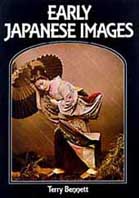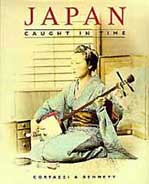BENNETT Terry
Book reviews of Terry Bennett's books on vintage Japanese photography.
by Philbert Ono
Early Japanese Images
 Reviewed on: Nov. 22, 1997
Last modified: 2005-04-03
Reviewed on: Nov. 22, 1997
Last modified: 2005-04-03
The most recent book in English devoted to early Japanese photography. Excellent introduction to late 19th-century and early 20th-century Japanese photography.
Published: 1996 Publisher: Charles E. Tuttle Company ISBN: 0804820333 Price in Japan: ¥3,280 Qualities: Hard cover, color photos Size: A4, 96 pp. Language: English
As the author states in the book's preface, there is little English documentation on early Japanese photography. (A stark contrast to the tons of such books in Japanese.) This book is therefore a welcome addition to the book shelf of vintage photo collectors, historians, and any layman interested in Japanese photography.
The book is divided into a text section, photos, and back matter which includes appendices. The text starts with an overview (by Sebastian Dobson) of the historical background of early Japanese photographs. The author then delves into the "how" (through the Dutch trading post in Nagasaki) and "when" (around 1848) of photography's first introduction to Japan. Important Western photographers who came to Japan and set up shop are introduced. They include Felice Beato, Baron Raimond von Stillfried, and Adolfo Farsari. The biographies of early Japanese photographers such as SHIMOOKA Renjo, UENO Hikoma, and OGAWA Kazumasa (Isshin) are also presented. The author then explains how he identified the photographers' works which is always difficult since most did not stamp their name on the prints they made. The book gives you a basic understanding of the early days of photography in Japan. The text is easy to read and not too long.
Then comes the images. It seems that over half the images have a deep sepia tone. Only some images are hand-colored. The images include a daguerreotype of Shimazu Nariakira, supposedly the oldest surviving portrait taken by a Japanese. The photos of the Meiji Emperor and Empress (taken in 1873 by UCHIDA Kuichi) were the first of an Imperial family member. Another interesting photograph has a woman walking through "a storm" in a photo studio (shown on the book's cover). Wires were inserted into her kimono to prop up the material to simulate a wind-blown effect. And the negative was scratched (!) to simulate rain. This pose is an imitation of a woodblock print showing a similar scene. (Many early Japanese photographs imitated the scenes and poses depicted in woodblock prints.) All the images are annotated at the back of the book. At least some of the images were borrowed from collectors for publication in this book.
The author is also devoted to photograph attribution and has made extensive research into identifying the photographer of early photographs. In Appendix 1, he lists over 1,200 photographs bearing a number and title. He uses this number and title (when provided) to index the photographs in numerical order and identifies the photographer when known. This appendix may be quite valuable to collectors who have photographs that at least show a number on the photograph. Of course, each photographer used his own numbering system. If you have two different photos with identical numbers, any title on the print can distinguish it from the other. Note that Sebastian Dobson has informed me that they discovered a lot of new information since the book's publication and so the book may not be completely up-to-date. Nevertheless, it is an excellent introduction to early Japanese photography. (Reviewed by Philbert Ono)
Japan Caught in Time
 Reviewed on: Nov. 22, 1997
Last modified: 2002-11-14
Reviewed on: Nov. 22, 1997
Last modified: 2002-11-14
Excellent introduction to Japanese photography in the late 19th-century.
Published: 1995 Publisher: Charles E. Tuttle Company ISBN: 4805305428 Price in Japan: ¥4,000 Qualities: Hard cover, color photos Size: Letter, 159 pp. Language: English By: Hugh Cortazzi and Terry Bennett
Very nice coffee-table book with color photos. Only one-fourth of the book contains text while the rest of the book features a large color photo on each page. The text introduces the historical background of the period (by Cortazzi) and the early history of photography in Japan (by Bennett). The photographs all came from the collection of Alexander Vasilyevich Grigoryev, a Russian botanist who was in Japan in 1879-80. The images have been preserved by the Russian Geographical Society in St. Petersburg. The photographs date from the 1870s and are attributed to Baron von Stillfried, Felice Beato, and USUI Shusaburo. Some photographs are unidentified as to who the photographer was.
The photographs are categorized as Yokohama and Hakodate, street life, domestic life, costumes and portraits, farming and handicrafts, and temples and shrines. The collector obviously sought a well-rounded representation of exotic Japan: Kago, rickshaws, palanquins, beggars, people bowing to each other, eating at home, lady playing the samisen (also on the book's cover), samurai in full armor, Shinto priest, portraits of young and old men and women, a tattooed body, children, farmers in the field, the preparation of rice, and more. Almost all the photos are hand-colored.
Hugh Cortazzi is a former British Ambassadar to Japan and Terry Bennett is an expert on early Japanese photography, prints, and books. This is another book to get if you're interested in the history of Japanese photography. (Reviewed by Philbert Ono)